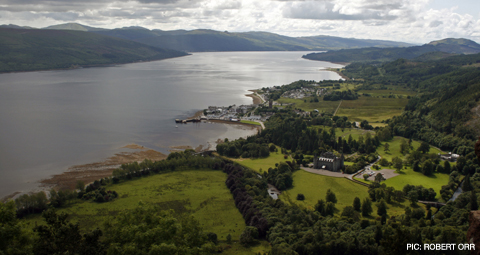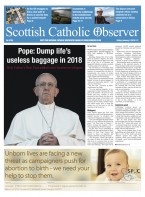January 5 | ![]() 0 COMMENTS
0 COMMENTS ![]() print
print

Ecumenism in Inveraray
In the latest of his alternative pilgrimages, ROSS AHLFELD visits the beautiful lochside town of Inveraray to find a fascinating church shared by two Christian denominations By ROSS AHLFELD
When I set out on my monthly pilgrimages I always like to take a few books to read. This month it was off to Inveraray and as always, I took along my good old Victorian guide book, Days at the Coast by Hugh MacDonald, which got taken out and read at various points on the way to Argyll, as well as Nomad by Alan Partridge, which has to be one of the funniest travel guides ever written. The third book was another very old book but this one was in German.
This particular book was kindly given to me by a distant relative many years ago. It is an old German book of sermons called Das Leben im Licht des Wortes Gottes written in 1886 by Pastor Friedrich Ahlfeld. Pastor Ahlfeld was a Lutheran Minster at the famous St Nikolai Church in Leipzig, a church strongly associated with non-violent protests against the East German government during the communist era.
In 1989, St Nikolai’s was at the centre of peaceful revolt against communist rule since it was the meeting place for the ‘Monday demonstrations’ (Montagsdemonstrationen) and prayers for peace (Friedensgebet). In earlier times, St Nikolai Church had been strongly associated with the music of JS Bach. The church saw four performances of Bach’s St John’s Passion on Good Friday. Today, St Nikolai Church describes itself as a church which is ‘offen fur alle’ (open for all). This is because it is a ‘Simultaneum Church,’ meaning that it is a shared church where Catholics use it for Mass alongside Lutheran services at different times.
The term Simultaneum was first used in 16th-century Germany as a kind of compromise. Such churches became common in Germany after the Reformation in regions where there happened to be a mix of both Catholics and Protestants.
Amazingly, there was also a different Pastor Ahlfeld at another Simultaneum church in the middle of the 18th century at the Old St Peter’s Church in Strasbourg. Just like Pastor Ahlfeld in Leipzig, his namesake in Strasbourg is also commemorated in a book published in 1910 called Monsieur l’abbé Ahlfeld, curé de Saint-Pierre-le-Vieux de Strasbourg.
As such, I’m always on the lookout for interesting spaces which are shared by different denominations and I recently visited one in the old town of Inverary.
All Saints Scottish Episcopal Church is a picturesque Gothic-style church built 1885 and it is a pleasant surprise to stumble upon this delightful little chapel just off the main street.
All Saints is the type of chapel which would not look out of place in the Norfolk countryside, the same type of parish church which features in the ghost stories of MR James and the poems of John Betjeman (or even Partridge’s Nomad). Except, this church is not in either Lowestoft or Yarmouth, it’s right here in the middle of the traditionally Presbyterian Argyll on the banks of Loch Fyne.
All Saints has a profound sense of holiness and the interior furnishings and architecture can be described as very ‘Catholic.’ I often hesitate to use terms such as Anglo-Catholic or high church Anglican despite the fact that most Scottish Episcopalian friends are fine with the term Anglo-Catholic—although, they are keen to stress the Episcopal Church’s own sense of its unique identity, tradition and autonomy within the wider Anglican Communion.
Regardless, when you enter All Saints, the first thing you notice is a perfect replica of Our Lady of Walsingham. Perhaps, this statue better expresses that which we share, more so than any denominational definition or classification.
Most importantly, there is Mass every Sunday at All Saints and the Catholic congregation of Inveraray are extremely grateful to the Episcopal Church for permitting them to worship in this very beautiful and historic church.
Equally, the Scottish Episcopal Church’s Fr Simon Mackenzie, who is responsible for mid-Argyll & Arran, describes the presence of the worshipping Catholic community as ‘a great blessing.’
More so, Fr Mackenzie tells me that they wish to make the whole Church area more accessible and friendly.
Heritage work is ongoing with regards to the church and the fine old, famous bell tower and hopefully this work will attract more interest in, and visitors to, All Saints.
Quite appropriately, All Saints is a Church with its very foundations in compromise and accommodation. For example, Fr Mackenzie also points out that the church was originally built for the Duchess of Argyll in 1880. She was an English-born Anglican and the daughter of the Bishop of St Albans while her husband, the eighth Duke, was firmly Presbyterian.
Yet, his wife was able to convince him to construct an Episcopal church so she could worship in Inverary. As such, the new church was consecrated by the Episcopal Bishop of Argyll and the Isles in 1886.
Later, in the 20th century, the 10th Duke was a great patron of All Saints, and the church flourished under his devotion. His spirituality was Anglo-Catholic, as had been the spirituality of the church since its dedication. Therefore, the liturgy was celebrated with great solemnity during those times.
For me, such practical arrangements at parish level are a far more tangible act of ecumenical unity than endless theological debates and discussions. Sometimes we spend too much time trying to get around our differences rather than simply getting on with carrying out the work which we can already do together.
More often than not, these shared works of unity are to be found in the societal and political realms rather than the doctrinal. A perfect example of this type of good work would be that which emerged from the aforementioned culture of Simultaneum church arrangements back in 1940s Germany.
For example, Fr Max Josef Metzger, the pacifist Catholic priest executed by the Nazis, came from Baden. Baden was a mixed region: the north was traditionally Lutheran while the south was strongly Catholic.
Fr Metzger was best known for founding the German Catholic Peace Association (Friedensbund Deutscher Katholiken). Yet he was also very much a product of Simultaneum, and as such Max Metzger went on to create the Una Sancta Brotherhood, a group which promoted unity between Lutherans and Catholics. For me, the sacrifice of men such as Fr Max represents the absolute pinnacle of where the very best of social and spiritual ecumenism can potentially take us, even during the very worst of times.
If you are in Inveraray to visit All Saints then I’d recommend calling into the well known George Hotel to sample its wide selection of fine ales. Although beware if you’re looking to catch a football match in the afternoon around Argyll.
My dad and I once went looking for a game in Inveraray and ended up back over in Dunoon because Dad used to manage Dunoon Juniors. We accidentally ended up watching the 2006 shinty Camanachd Cup Final between Kingussie and Fort William instead.
As it turns out, this was quite an acclaimed match in which the renowned ‘Ronaldo of the Glens,’ Ronald Ross, scored what can only be described as a wonder goal.
Most of all, the craic from the shinty lads that day was hilarious and as our dear Pope Emeritus Benedict tells us: “Where joylessness reigns, where humour dies, the spirit of Jesus Christ is assuredly absent.”











